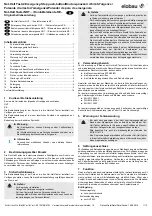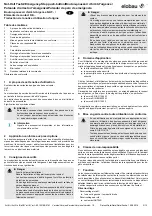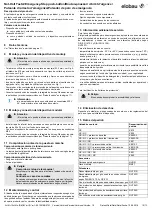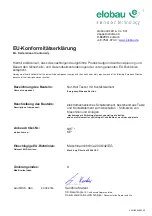
Not-Halt Taster/Emergency-Stop push-button/Bouton-poussoir d'arrêt d'urgence/
Pulsante di arresto d'emergenza/Pulsador de paro de emergencia
Art.-Nr./Art. No./Réf./N° art/N° art.: 9010019B01M
Version/Version/Version/Versione/Versión: 1.0
Datum/Date/Date/Data/Fecha: 15.08.2016 4/13
Scope of supply
- Built-in version:
As a separate push-button and contact element
- Mounted version:
As a separate push-button, contact element and mounted enclosure
8
Technical specifications
See "Technical specifications" beginning on page 11.
9
Installation and connection of the built-in version
- Drill installation hole (22.3 mm) in the installation board, see Fig. 2; the
Ø 9 mm hole is only required for the types with an illuminated blocking pro-
tection collar, see Fig. 2.
- Push the push-button through the installation hole and fix with locking nut
(max. torque 2.5 Nm).
- Mount contact element and turn clockwise through one eighth of a revolution.
The contact element locks into place, see Fig. 1.
- Check whether the contacts of the failure protection are closed when the
contact element is locked in position and the button is not pressed.
- Connect connection cables to the terminal blocks. Observe the permitted
electrical and mechanical values (see "Technical specifications" on
page 11).
10 Installation and connection of the mounted version
- Mount the lower part of the enclosure on a flat surface at a distance of
59 x 39 mm (see bottom of enclosure).
- Feed the connection cable through one of the two M20 cable bushings.
- Connect connection cables to the terminal blocks. Observe the permitted
electrical and mechanical values (see "Technical specifications" on
page 11).
11 Check before commissioning
Mechanical operation test
- The button is securely fixed.
- The mounting nut is tightened so that no play can be detected in the longitu-
dinal direction.
Electrical operation test
- Start machine.
- Press button.
12 Maintenance and inspection
The inspection interval is to be defined by the designer with the aid of a risk
analysis. However, it is recommended that the responsible safety officer
trigger the Emergency-Stop push-button at least once a year and check for
correct operation.
- trouble-free operation
- no manipulations detected
- secure mounting of components
- tightness of the cable bushings
- no loose cable connections
13 Further operating instructions
For hygienic areas:
The following Emergency-Stop push-button is, among other things, also suitable
for use on food processing equipment in the food industry, the splash zone and
non-food sector (definition acc. to DIN EN 1672-2 and DIN ISO 14159):
NHT02D
The following should be noted:
- Operating temperature -30°C to +40°C (briefly up to +70°C)
- Permanent contact with hydrocarbons (e.g. petrol, oil, grease, etc.) should
be avoided
- Limited UV resistance (install additional protection for outdoor use)
- Preferably choose a horizontal mounting position to allow independent drain-
ing of liquids
- Clean and disinfect before the first start, as required (depending on the de-
gree of soiling) and at regular intervals
- Use of commercially available, low-concentrated cleaners and disinfectants
is recommended
- If externally visible parts are damaged, replace them with equivalent hygienic
equipment
Use of "protective collar":
14 Disposal
Dispose of packaging and used parts in accordance with the regulations of the
country in which the device is installed.
15 Ordering details
Warning
Installation may be performed by authorized personnel only!
Note
When using illuminated push-buttons, a maximum of 230 V AC
may be connected to the contact elements.
Warning
Installation may be performed by authorized personnel only!
Danger
-
Check stopping of the machine
!
Check whether the machine stops when the Emergency-Stop
push-button is pressed.
-
Procedure in the event of a fault
Damage and operational faults of the Emergency-Stop push-
button may result from mechanical overload or the exertion of
external force. Carry out operational test as described in point 7.
Danger
The user must check accessibility and availability.
Contact elements
Order designation
NC
KE10
NC / NC
KE20
NC / NC + failure protection
KE20SF
NC / NC + failure protection / illumination
KE20SFB
NC / NC / NO
KE21
NO / NC / NC + failure protection
KE21SF
NO / NC / NC + failure protection / illumination
KE21SFB
NC / NC / NC + failure protection
KE30SF
NC / NC / NC / NO
KE31
NC / NC / NC / NC
KE40
Accessories
Emergency-Stop enclosure
NHG01
Installation wrench
MS01
Push-Button
Twist to release
NHT01D
Twist to release, suitable for hygienic environments
acc to DIN EN 1672-2 and GS-FW
NHT02D
With blocking protection, twist to release
NHT03D
With blocking protection, twist to release,
with illumination
NHT04D
With blocking protection, key release, with illumination NHT04S
With protective collar, twist to release
NHT05D














